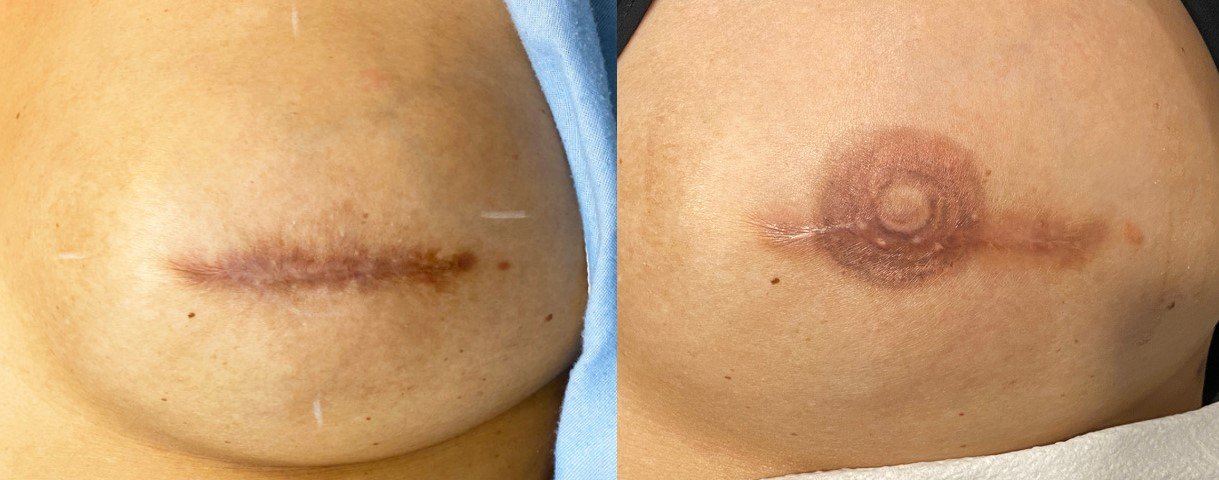What is Nipple Reconstruction?
The nipple and areola are typically removed with a mastectomy for most patients. Consequently, a lot of women decide to get nipple reconstruction surgery. Nipple reconstruction surgery follows breast reconstruction surgery, which rebuilds the breast mound. It aims to restore the darker-coloured areola and raised nipple. It's crucial to remember that you are more likely to experience post-surgical issues if your breast cancer is treated with radiation.Nipple reconstruction surgery methodsSeveral techniques can be employed to reconstruct your nipple, depending on the state of your new breast tissue and your surgeon's preferences.Skin flap
The nipple is created by folding and stitching together tiny skin flaps from your repaired breast. The nipple is made to seem higher than the breast mound by manipulating the skin. It is occasionally necessary to add extra skin, fat, or artificial fillers to make the nipple more erect.grafting skin
Your surgeon could use a skin graft if there isn't enough tissue to form a nipple from the new breast. Typically, grafts are obtained from the groin, where the legs and torso connect, the buttock crease, the abdomen, or the thigh.sharing of autologous grafts or nipplesA part of your unaffected breast's nipple may be grafted onto your new breast if it is large enough. A nipple sharing procedure or autologous graft is what this is.Medical tattooing
The areola and nipple can be reconstructed naturally with tattooing. In addition to tattooing, skin grafts may also be employed. Women who don't want additional surgeries might only decide to get a tattoo. It's crucial to remember that the nipple won't be lifted in this case.Medical tattooing is done by plastic surgeons and their clinical staff. However, many agree that expert tattoo artists employ three-dimensional methods to create a far more realistic nipple and areola.Your other nipple's colour is picked for the pigments. Following nipple reconstruction, tattooing is frequently done. Pigments may deteriorate or alter over time. You might need to get the tattoo touched up due to this.Medical tattooing is not usually covered by insurance, especially if it is not done by a medical professional.When is the procedure available, and how long does it take?
Nipple surgery is often done after your breast has recovered following reconstructive surgery if silicone or saline implants were used to restore your breast. This usually occurs in three to four months. Dependable source Your nipple may be restored simultaneously with or later if your breast was rebuilt using skin from your abdomen.Nipple reconstruction surgery might take anywhere from 30 minutes to over an hour, depending on the technique employed.ComplicationsSerious side effects during nipple repair are uncommon. The new tissue will occasionally deteriorate and require replacement. The freshly repaired nipples do have a tendency to flatten down over time and could need further surgery.How to prepare for surgeryNipple reconstruction is often performed with a local anaesthetic as an outpatient procedure at your doctor's office. To determine what type of anaesthetic will be used in your situation, speak with your surgeon. You should make arrangements for a ride home after the event.You'll receive advice from your doctor on how to get ready for surgery. The following might be suggested:· For a certain amount of time before the procedure, refrain from eating or drinking.· Take no medicine on the day of the procedure.· You could be told to use antibacterial soap the night before or the morning of the procedure.· After a shower, avoid using deodorant, lotion, or scented goods.· Dress comfortably and loosely for your procedure.Post-surgery and post-recoveryYour nipple will be sore and vulnerable to injury as it heals. It may appear more rounded at first, but it will become flattered after healing.A plastic nipple protector might be sewn on to safeguard your nipple if it was created from a skin transplant. After approximately a week, your doctor will remove the sutures and nipple protection.You will be sent home wearing a sports bra or surgical bra. The surgical dressing will remain in place as a result. For a few days, your surgeon will instruct you to keep on the bra and bandages. They are often taken out when you have your post-operative exam.After getting your nipple and areola tattooed for a few days, you can notice some flakiness and crusting.Your doctor will suggest how to take care of your new nipples. Usually, an antimicrobial cream is advised. As your new nipples heal, cushion them with cotton or gauze inside your bra. Don't scrape your nipples or use abrasive soaps until they have recovered.Cost of nipple reconstruction surgery
Federal legislation requires most insurance providers to pay for prostheses and surgical breast reconstruction. This includes the following plans, provided they began on or after October 1, 1998. They provided they pay for your mastectomy's medical and surgical expenses:Individual health insurance plans are not connected to your employer, HMOs, or group health insurance. Additional legislation that broadens coverage exists in several states.Co-payments and deductibles
Remember that you might need to pay your annual deductible and co-pays for any medical procedures.Before undergoing any medical operations, contacting your insurance provider and your surgeon's insurance claims team is usually a good idea.Insurance companies frequently do not pay for three-dimensional tattooing, typically done in a tattoo parlour rather than a doctor's office.


